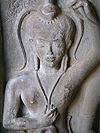|
Apsara (अपसरा, អប្សរ)
Sanskrit-Khmer.
The female divinities or nymphs and celestial dancers of the
Tavatimsa
Heaven. They were produced during the Churning of the
Ocean of Milk.
From Sanskrit their name can be translated as ‘emerged from liquid’, ap meaning
‘liquid’ and sara meaning ‘to move or emerge from’. In Hindu mythology, they are
the companions of the
gandharvas, the male celestial
musicians, but in
Khmer mythology they appear solitary,
mainly in temple decorations (fig.), e.g. in
Angkor Wat.
The are the attendants of
Kama, the god of love
and they are able
to change shape at will. They are sometimes employed by the gods to seduce
ascetics, and are the sensual reward for kings and braves who died a hero's
death. In art, they are often depicted in murals and lintels (fig.),
floating in the air (fig.). In
Cambodia, Apsara Dance (fig.) is the Khmer equivalent of
Khon, i.e. Thai Classical Dance (fig.).
In Thai, Apsara are called
Apsorn or
Apson, and in Khmer they are usually referred to as
Thep Apsar (ទេពអប្សរ), i.e. ‘Fairy’, though literally it can be translated as ‘Adorning Angel’. Whereas there is no plural form in the original language, in English they are as a group often referred to as Apsaras. The subdistrict of Nang Ram (นางรำ), i.e. the ‘Dancing Lady,’ in
Nakhon Ratchasima Province, has thematic street lanterns of Apsara Dancers in reference to the name of this
tambon. See also
TRAVEL PICTURES (1), (2) and (3), as well as THEMATIC STREET LIGHT (1),
(2) and (3).
回






|

